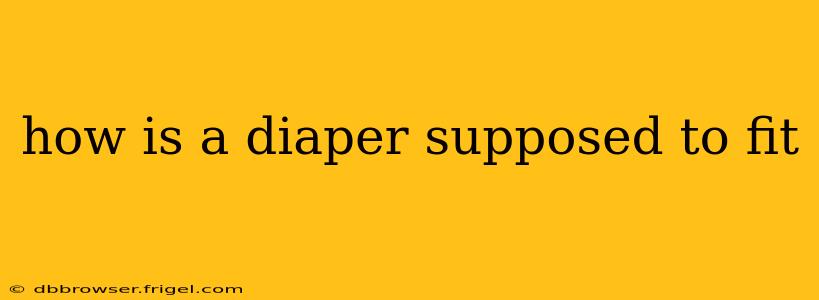How is a Diaper Supposed to Fit? A Comprehensive Guide
Choosing the right diaper and ensuring a proper fit is crucial for preventing leaks, rashes, and discomfort for your baby. A poorly fitting diaper can lead to a lot of extra laundry and a grumpy baby! This guide will walk you through everything you need to know about achieving the perfect diaper fit, addressing common concerns along the way.
What are the Signs of a Poorly Fitting Diaper?
Before we dive into the specifics of fit, let's identify the tell-tale signs of a diaper that isn't quite right. These include:
- Leaks: Frequent leaks, especially around the legs or back, are a major indicator of a poor fit.
- Redness or Rash: A diaper that's too tight can restrict blood flow and irritate your baby's delicate skin, leading to redness or a rash.
- Gaping: If there are large gaps around the legs or waist, the diaper is likely too loose and won't contain messes effectively.
- Indentations: Deep indentations from the diaper's leg cuffs or waistband on your baby's skin are a sign the diaper is too tight.
- Baby's Discomfort: Your baby might fuss or cry more than usual if the diaper is uncomfortable.
How Should a Diaper Fit? A Step-by-Step Guide
The ideal diaper fit is snug but not restrictive. Here's a step-by-step guide to achieving the perfect fit:
-
Choose the Right Size: Start by selecting the appropriate size based on your baby's weight. Always refer to the manufacturer's size chart. Don't be afraid to size up if your baby is on the higher end of the weight range for a given size.
-
Lay the Diaper Flat: Unfold the diaper and lay it flat on a surface. Ensure the absorbent pads are evenly distributed.
-
Position the Diaper: Place your baby's bottom on the center of the diaper, aligning the waistband with their belly button.
-
Fasten the Tabs: Bring the front tabs around and fasten them securely, ensuring they are snug but not too tight. You should be able to comfortably fit one or two fingers between the waistband and your baby's belly.
-
Check the Leg Cuffs: Ensure the leg cuffs fit snugly around your baby's thighs, preventing leaks. There should be no gaps.
-
Adjust as Needed: If you notice gaps or leaks, try adjusting the tabs for a better fit. You might need to experiment with different fastening techniques to find what works best for your baby.
What if the Diaper is Too Tight or Too Loose?
-
Too Tight: If the diaper is too tight, it will leave red marks on your baby’s skin and may cause discomfort. Try loosening the tabs or switching to a larger size.
-
Too Loose: A loose diaper will likely lead to leaks. Try tightening the tabs or switching to a smaller size.
How Often Should I Change My Baby's Diaper?
Changing diapers frequently is essential for preventing diaper rash and keeping your baby comfortable. Aim to change your baby's diaper every 2-3 hours, or more frequently if needed. You should also change a diaper immediately after a bowel movement.
What Kind of Diaper Should I Use?
Choosing between disposable and cloth diapers is a personal decision. Disposable diapers offer convenience, but cloth diapers are a more environmentally friendly option. Consider your lifestyle, budget, and environmental concerns when making your choice.
What are Some Tips for Preventing Diaper Leaks?
-
Choose the Right Diaper: Select a diaper size appropriate for your baby's weight and consider using overnight diapers for nighttime use.
-
Ensure a Proper Fit: Follow the steps outlined above to ensure a snug but not overly tight fit.
-
Check for Leaks Regularly: Periodically check your baby's diaper for leaks, especially after periods of activity or sleep.
By following these guidelines, you can ensure your baby enjoys comfortable and leak-free diaper changes. Remember, every baby is different, so finding the perfect fit may involve some trial and error. Don't hesitate to experiment with different diaper brands and sizes to find what works best for your little one.
